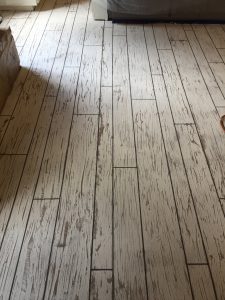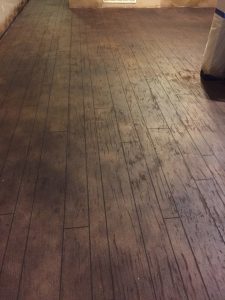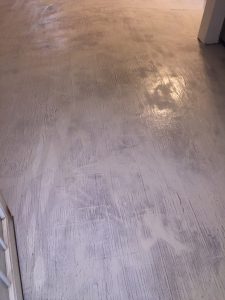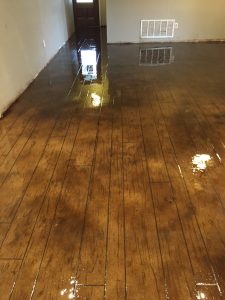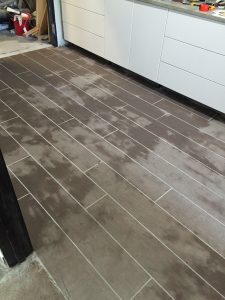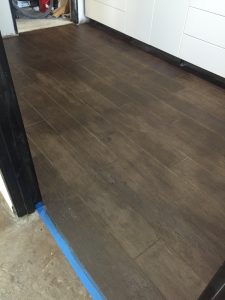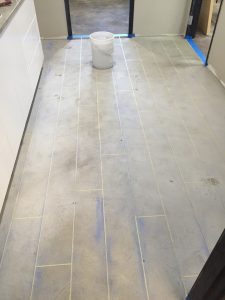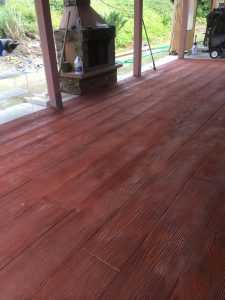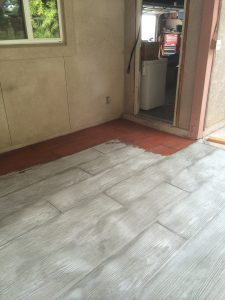Decorative Concrete Trends: 4 Methods to Get the Faux Wood Look
One of the hottest flooring trends today is a faux wood look. Just walk through your local hardware store and see the various wood tiles available. Creative applications are also plastered across social media sites.
For years, the only way to achieve a wood texture in concrete was stamping. While this practice is still used today, there are several new ways to achieve a more authentic wood finish. Check out these four popular techniques and applications:
- Stamped Concrete Method (Mostly Exterior)
As mentioned, concrete stamping has been around for years. This traditional method is still great for large areas that require heavy traffic and great traction.
Technique: You can either pour new concrete or apply a cementitious overlay and stamp the wood pattern using rubber stamps. Different coloring methods can be used, with the most popular being to color the entire floor with a base color and then antique or accent with the second and third colors.
- Broom Finish/Trowel Method (Interior/Exterior)
This wood-look method leaves you with a less aggressive texture than the stamp method. The final product looks closer to real wood (when compared to stamping), and it requires less material. The coloring techniques are generally the same.
Technique:
- Start by applying Super-Krete Bond-Kote with a squeegee to achieve a smooth uniform finish.
- Next, apply a fiber-infused tape (1/4” or 1/2”) in the desired wood plank pattern.
- Apply another coat of Super-Krete Bond-Kote with a squeegee and immediately drag a concrete finishing broom through it.
- Immediately after the brooming, drag a pool trowel through the wet product in the same direction. This will create a suction effect that will leave a wood grain texture.
- Once dry, pull your tape and stain as you would any other stamped concrete application.
- Light Broom/Trowel Method (Interior)
This method is very similar to traditional broom/trowel method. The two main differences are the intensity of texture and the coloring application. Since you cannot rely on the texture fully to give you the wood appearance, coloring becomes critical with this method.
Technique:
- Apply a squeegee coat of Super-Krete Bond-Kote with a squeegee to achieve a smooth uniform finish.
- Second, apply fiber-infused tape (1/4” or 1/2”) in the pattern desired.
- Apply either Bond-Kote or Micro-Bond and lightly brush through the wet product with a broom or a chip brush. The idea is to keep the texture to a minimum.
- When the material begins to set-up, you can lightly knock down the texture further with a trowel.
- Once the product has dried, you can remove the tape and start coloring. To achieve the most authentic look, contractors will stain each plank individually. This coloring method is labor intensive and does take some artistry.
- Grouted Broom Texture Method (Interior)
Anyone – from seasoned pros to concrete novices – can achieve the most authentic faux wood finish using the grout method. The finished floor is the smoothest of all methods, plus it’s easier to recreate the same look for future jobs.
Technique:
- Apply a squeegee coat of Super-Krete Bond-Kote. Yet this time, you will need to integrally color this coat with the grout color you desire.
- Once dry, tape out your wood plank pattern with fiber-infused tape (1/4” or 1/2”).
- Apply another coat of Bond-Kote that’s integrally colored in the way your wood grain should appear.
- While still wet, broom and drag a trowel in the direction of the planks.
- And now here is where the magic happens: Once dry, apply Super-Krete Micro-Bond with a magic trowel over the wood grain texture. This coat should act like a grout.
- Once cured, you then lightly sand the floor exposing the peaks of the colored texture.
- The last step is to color the floor. Spray Concrete Dye over the entire floor.





